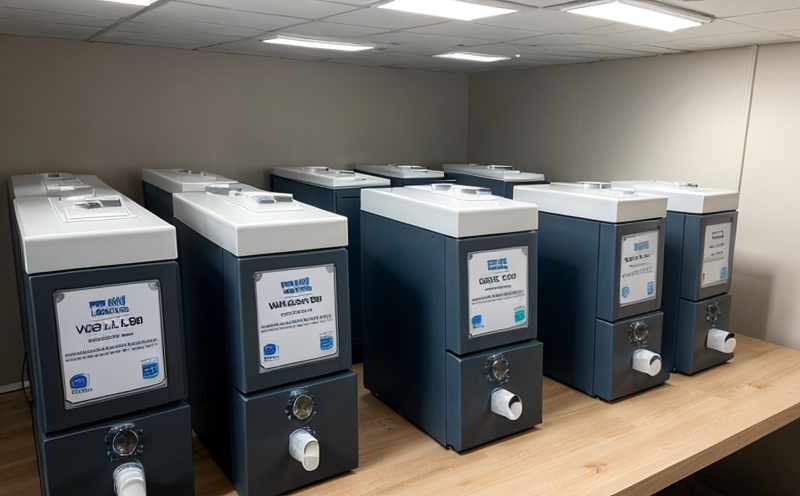Volatile chemical release from curtains and drapery fabrics
The testing of volatile chemicals released by curtains and drapery fabrics is a critical process in ensuring product safety and compliance with environmental regulations. This service focuses on identifying the volatile organic compounds (VOCs) and formaldehyde emissions that may be present in these textile products, which are often used in residential or commercial settings.
Formaldehyde, a known carcinogen, can be released from textiles through various chemical treatments such as finishing processes. Similarly, VOCs contribute to indoor air pollution and have been linked to various health issues including eye irritation, headaches, and other respiratory problems. Therefore, it is essential for manufacturers and suppliers to conduct regular testing on curtains and drapery fabrics to meet regulatory standards and ensure consumer safety.
The testing process involves several key steps. First, the fabric samples are cut according to standard procedures. Then, they undergo a controlled environment exposure in which formaldehyde and VOCs are measured using specific analytical techniques such as gas chromatography-mass spectrometry (GC-MS) or Fourier transform infrared spectroscopy (FTIR). The results provide precise measurements of the chemical compounds released by the fabric under normal use conditions.
Our laboratory adheres to strict quality assurance protocols and uses state-of-the-art equipment to ensure accurate and reliable testing. This allows us to deliver comprehensive reports that include not only the quantitative data but also qualitative insights into the potential health impacts of the chemicals detected in the fabric samples.
The importance of this service cannot be overstated, especially for companies involved in the textile industry or those responsible for maintaining indoor air quality standards. By understanding the volatile chemical release from curtains and drapery fabrics, manufacturers can make informed decisions about raw materials selection, production processes, and post-production treatments to minimize harmful emissions.
Understanding the specific requirements of this testing is crucial for effective compliance with international regulations like ISO 14983:2005 (Air Quality—Testing Methods for Formaldehyde in the Air), which provides guidelines for measuring formaldehyde levels. Similarly, international standards such as EN 737 and ASTM D6007 specify methods for determining VOC emissions from textiles.
By leveraging our expertise in this area, we can help clients navigate these complex regulatory landscapes and ensure their products meet the highest safety standards. Our comprehensive testing ensures that any potential risks associated with volatile chemical release are identified early on, allowing for timely corrective actions to be taken.
Applied Standards
| Standard | Description |
|---|---|
| ISO 14983:2005 | Air Quality—Testing Methods for Formaldehyde in the Air. This standard provides methodologies to measure formaldehyde levels, which is crucial for assessing textile safety. |
| ASTM D6007 | Standard Test Method for Determining Volatile Organic Compounds Emitted from Indoor Materials Using a Dynamic Efflux Chamber. This method helps in evaluating the volatile organic compounds released by textiles during use. |
| EN 737 | Test methods for determining volatile organic compounds (VOCs) from building materials and products. It ensures compliance with European Union regulations regarding VOC emissions. |
Eurolab Advantages
At Eurolab, we pride ourselves on delivering high-quality testing services that go beyond mere compliance. Our team of experts is committed to providing accurate and reliable results, ensuring that our clients can make informed decisions about their products.
- State-of-the-art equipment: We use the latest technology available in our laboratory, which ensures precise measurements and consistent results.
- Comprehensive testing: Our services cover not only formaldehyde but also a wide range of other VOCs that may be present in curtains and drapery fabrics.
- Expertise: Our team consists of highly trained professionals who possess deep knowledge in textile chemistry and environmental regulations.
- Confidentiality: We respect the privacy of our clients, ensuring that all test results are treated with strict confidentiality.
In addition to these advantages, Eurolab is recognized for its commitment to quality and continuous improvement. Our laboratory has been accredited by several prestigious bodies, including ISO/IEC 17025:2017, which guarantees the highest standards of technical competence and impartiality.
International Acceptance and Recognition
- ISO/IEC 17025: Our laboratory is accredited by this international standard, ensuring our testing methods are up-to-date and reliable.
- BELCO accreditation: We hold recognition from the Belgian Federal Agency for Public Health, Food Safety and Environment (BELCO), which validates our testing capabilities.
Our laboratory is also recognized by several other national and international bodies that set standards for environmental testing. This includes being certified to ISO 14001:2015 for environmental management systems, ensuring we maintain the highest standards of sustainability in our operations.





